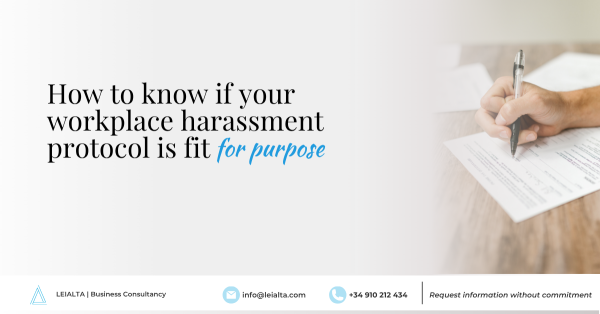
In recent months, both the courts and the Spanish Labour Inspectorate have stepped up their focus on a key aspect of occupational risk prevention: the actual effectiveness of workplace harassment protocols. This means it is no longer sufficient to have a document stored in a folder or uploaded to the intranet. Increasingly, authorities require that such protocols be known, applicable, up-to-date and tailored to the organisational reality of each company.
For this reason, this alert takes an in-depth look at a general obligation for all employers.
Legal requirements and practical implications
This shift in approach is neither accidental nor temporary. It responds to a combination of legal and social developments. On the one hand, the implementation of ILO Convention No. 190 and European regulations on equality, diversity and occupational health are laying the groundwork for a new paradigm in preventive culture. On the other hand, growing public awareness of the effects of harassment has turned this issue into a key element of corporate reputation, internal sustainability and people management.
Does your harassment protocol exist or is it truly enforced?
In this context, it is essential to assess whether your workplace harassment protocol is a real instrument for prevention and action, or simply a generic document that only appears to meet formal requirements.
One of the most common mistakes is assuming that the mere existence of a protocol is enough. However, recent cases show that many companies sanctioned by the Labour Inspectorate had a protocol in place—but one that was inadequate, out of date, or unknown to employees. The preventive effectiveness of a protocol is not measured by its length or the date of approval, but by its actual implementation and use.
Common shortcomings in harassment protocols
More and more organisations are relying on off-the-shelf templates with no connection to their internal structure or effective communication channels. This approach not only limits their usefulness in real situations, but also increases legal and reputational risks—especially in companies with complex structures, multiple sites or remote working arrangements.
Signs your protocol needs revising
You may be stuck in a situation without realising it. Warning signs include:
- The protocol was implemented more than two years ago and has not been updated.
- No individual or committee has been appointed to handle complaints.
- The document lacks clear timelines, confidential reporting channels, or procedural safeguards.
- Staff have not been trained on how to act in the event of harassment.
Who is responsible for the protocol?
While regulations do not require the creation of an Equality Committee in every case, it is essential to designate a specific person or team to receive, investigate and resolve reported incidents. This role must uphold the principles of confidentiality, impartiality and protection against retaliation.
A lack of clarity regarding this role—or the fact that employees are unaware of its existence—is one of the most frequently cited deficiencies in recent inspection reports.
Training and clear communication
Internal training is critical. A protocol without training is ineffective. Training should be provided both to those responsible for managing the protocol and to all staff members. Moreover, the protocol must be subject to ongoing review, and written in clear and accessible language—it is not a static document.
In a regulatory environment that is increasingly demanding and socially aware, LEIALTA understands these challenges. That is why we work with companies across all sectors to support them in the design, review and implementation of workplace harassment prevention protocols. Our approach is strategic, technical, and adapted to the specific context of each organisation.
We combine legal compliance with the goal of creating safer, more cohesive, and more sustainable workplaces. Because prevention is not just about ticking boxes—it’s about protecting, caring, and fostering a culture of respect.
